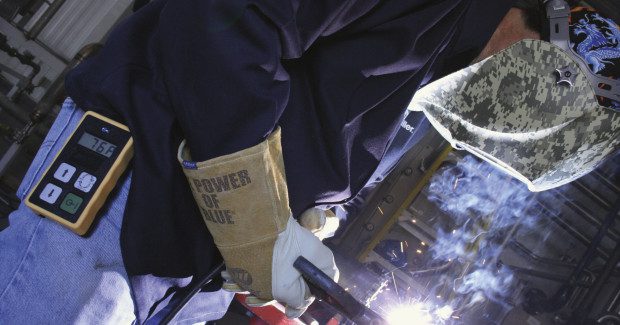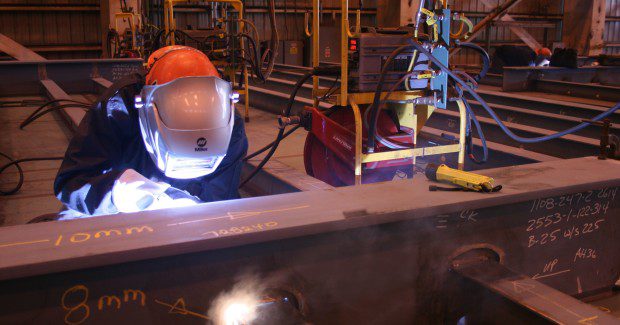Remote Welding Controls Offer Benefits in Fabrication Applications, Too
Beyond the field or jobsite, the benefits of remote control technologies in fabrication settings can be sizeable: more time spent welding and less time moving around; better welds resulting in less rework; and fewer cables to string and manage in the work area.
Posted: April 23, 2014
Remote control welding technologies offer numerous well-known benefits in field applications. The technologies provide the ability to make process changes and parameter selections at the weld joint, saving time, increasing productivity and improving jobsite safety. But welding operators should know that remote control technologies aren’t just for the field or jobsite. The benefits they offer translate well to fabrication and manufacturing applications to help improve productivity, quality and worker safety in shop settings.
A RANGE OF OFFERINGS
Whether a welding operation uses traditional processes like Stick, TIG, MIG or Flux-Cored, or more advanced ones (e.g., Regulated Metal Deposition or RMD®), there’s a remote control solution to make life easier. Choosing between the remote control offerings depends largely on the welding process being used and the requirements of the application, but all of the technologies help improve productivity, quality and safety.
Some welding operators may have hesitated in the past to use point-of-use controls because of the additional control cable the technology required. Control cables are one more piece of equipment that can be damaged, cut or broken, and they can be expensive to maintain and repair. In fact, there have been reports of companies spending $1 million a year in downtime and repair for control cables. The additional cables also result in extra clutter in the work area, which can pose safety hazards to employees.
However, advancements in remote control technologies offered by some manufacturers eliminate the need for extra control cables, instead using the existing weld cable to communicate information between the power source and the feeder. There are also remote control technologies that allow welding operators to change output voltage and weld process at the feeder, saving a trip to the power source.
A testimonial showing how a wireless remote w/ digital display improves the ability for a pipeline welder to properly set welding parameters. Going wireless also makes the remote much easier to handle and store, and eliminates one more wear item (the cord) that can cause downtime and repair costs.
Some remote systems detect polarity when establishing communication between the feeder and the power supply, and automatically select the appropriate welding polarity for the job. Other remote control technologies let welding operators change processes remotely with the push of a button. Wireless remote hand and foot controls also are options with some systems.
PRODUCTIVITY GAINS
Complete control at the weld joint significantly minimizes the downtime that welding operators spend traveling back and forth from the power source. This benefit results in more arc-on time, which helps welding operators complete more welds and achieve higher overall productivity.
When operators can stay put at the weld, it also helps reduce fatigue, which can positively impact productivity. Eliminating downtime to maintain and repair control cables further adds to productivity gains for welding operations.
QUALITY IMPROVEMENT
Putting the weld controls next to the location of the weld also encourages proper machine settings and helps ensure better quality. It reduces interruptions by minimizing the need to walk back and forth to the power source. Easy access to the remote controls also means welding operators don’t have to settle for less than optimal settings or try to adjust their technique to accommodate for the wrong parameters in order to gain good weld quality. This is especially critical when performing code-quality work.
The remote control technologies also allow operators to precisely set arc voltage at the feeder, and monitor the actual arc voltage and current delivered to the weld using the digital meters on the feeder. These features help remove guesswork when it comes to adhering to weld procedures.
SAFETY UPSIDES
Reducing the need for welding operators to travel back and forth from the power source to the weld location not only improves productivity and quality, it can have a big impact on safety as well. The less walking and moving around the work area, the fewer the opportunities for falls and accidents.
While the distance between the welding power source and the feeder may not be as far in fabrication and manufacturing settings as it typically is on a construction site, reducing the need to go any distance still reduces exposure to hazards such as tripping on clutter.
A SOLUTION WITH MANY BENEFITS
It’s likely that every welding operation cares about productivity, weld quality and worker safety. Remote control welding technologies can help companies improve in all three areas, even indoors. The benefits of remote control technologies in fabrication settings can be sizeable: more time spent welding and less time moving around; better welds resulting in less rework; and fewer cables to string and manage in the work area.













